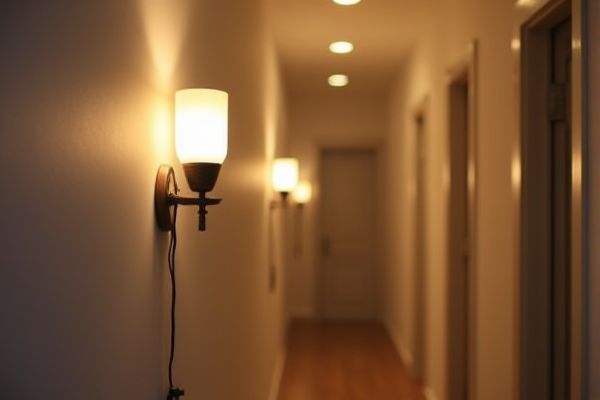
LED hallway lights offer superior energy efficiency, longer lifespan, and reduced maintenance costs compared to incandescent hallway lights, which consume more power and generate excessive heat. Explore the rest of the article to discover how upgrading your hallway lighting can enhance both ambiance and savings in your home.
Table of Comparison
| Feature | LED Hallway Light | Incandescent Hallway Light |
|---|---|---|
| Energy Efficiency | Up to 80% more efficient | High energy consumption |
| Lifespan | 25,000 to 50,000 hours | 1,000 to 2,000 hours |
| Heat Emission | Low heat output | High heat output |
| Brightness | Bright, available in various color temperatures | Warm light, limited color options |
| Cost | Higher initial cost, lower long-term cost | Lower initial cost, higher long-term cost |
| Environmental Impact | Eco-friendly, recyclable, less CO2 emissions | Less eco-friendly, higher CO2 emissions |
| Durability | More durable and shock-resistant | Fragile, susceptible to breakage |
| Light Quality | Consistent brightness, flicker-free | Can flicker, less uniform light |
Introduction to LED and Incandescent Hallway Lights
LED hallway lights use light-emitting diodes to provide energy-efficient, long-lasting illumination with minimal heat output. Incandescent hallway lights operate through a filament heated until it glows, offering warm light but consuming more electricity and having a shorter lifespan. The choice between LED and incandescent lighting impacts energy consumption, maintenance costs, and overall brightness quality in hallway settings.
Energy Efficiency Comparison
LED hallway lights consume up to 80% less energy compared to incandescent bulbs, significantly reducing your electricity bills. The energy efficiency of LED lights results from advanced semiconductor technology that converts most energy into light rather than heat. Choosing LED hallway lighting not only lowers your carbon footprint but also extends bulb lifespan, minimizing replacement frequency and maintenance costs.
Lifespan and Durability Differences
LED hallway lights offer a significantly longer lifespan, typically lasting up to 25,000 to 50,000 hours compared to incandescent lights which average around 1,000 to 2,000 hours. The durability of LED lights is enhanced by their solid-state construction, making them more resistant to shocks and vibrations, whereas incandescent bulbs are fragile due to their delicate filaments. Choosing LED hallway lighting ensures you benefit from reduced maintenance and fewer replacements, improving overall efficiency and cost-effectiveness in your home.
Light Quality and Brightness
LED hallway lights offer superior light quality with consistent brightness, providing crisp, clear illumination that remains stable over time. Incandescent hallway lights emit a warm, softer glow but tend to dim gradually and lose brightness as the bulb ages. LEDs deliver higher lumen output per watt, ensuring brighter and more efficient lighting ideal for hallway visibility and safety.
Cost Analysis: Initial and Long-term
LED hallway lights have a higher initial cost compared to incandescent bulbs but offer significant long-term savings due to lower energy consumption and longer lifespan, typically lasting up to 25,000 hours versus 1,000 hours for incandescent. Incandescent lights consume more electricity, resulting in higher monthly utility bills, while LEDs drastically reduce energy expenses over time. Your total cost of ownership is reduced with LED lighting, making it a more cost-effective and sustainable solution for hallway illumination.
Environmental Impact
LED hallway lights consume significantly less energy compared to incandescent bulbs, reducing carbon emissions and lowering electricity demand. Incandescent hallway lights generate more heat and have a shorter lifespan, leading to increased waste and resource consumption. Switching to LED technology supports sustainability by minimizing environmental impact through energy efficiency and longer durability.
Installation and Compatibility
LED hallway lights offer straightforward installation with standard fixtures and are compatible with most dimmer switches, reducing the need for electrical upgrades. Incandescent hallway lights may require compatible dimmers and often consume more energy, making them less efficient for modern systems. Your choice should consider LED's adaptability to various wiring setups, ensuring seamless integration and enhanced energy efficiency.
Maintenance Requirements
LED hallway lights require significantly less maintenance than incandescent lights due to their longer lifespan, typically lasting 25,000 to 50,000 hours compared to the 1,000 to 2,000 hours of incandescent bulbs. The reduced frequency of replacements lowers maintenance costs and labor efforts, especially in commercial or multi-unit residential buildings. Incandescent bulbs also generate more heat, which can contribute to faster fixture wear and increased maintenance needs over time.
Safety Considerations
LED hallway lights generate significantly less heat compared to incandescent bulbs, reducing the risk of burns or fire hazards in confined spaces. Incandescent lights, operating at higher temperatures, pose increased safety concerns, especially in areas with limited ventilation or near flammable materials. The longer lifespan and lower energy consumption of LED lights also contribute to safer electrical usage and fewer bulb replacements, minimizing exposure to potential electrical hazards.
Which Hallway Light Is Right for You?
LED hallway lights offer superior energy efficiency, longer lifespan, and cooler operation compared to incandescent bulbs, making them ideal for reducing electricity costs and maintenance frequency. Incandescent hallway lights provide warmer color tones and lower upfront costs, appealing to those prioritizing ambiance and initial budget. Choosing the right hallway light depends on your preferences for energy savings, light quality, and long-term expenses.
 homyna.com
homyna.com